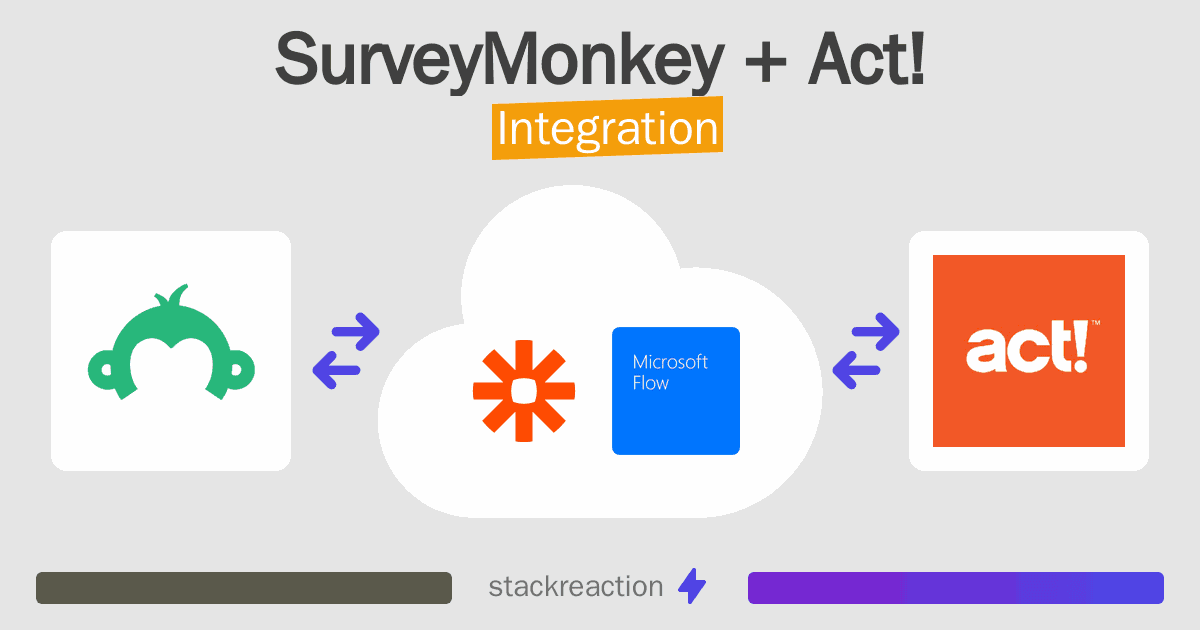How to connect SurveyMonkey and Act!
SurveyMonkey and Act! integration is available through workflow automation tools – Zapier or Microsoft Power Automate. With the combination of 22 SurveyMonkey triggers and 16 Act! actions, you can create hundreds of integration workflows to automate your work.
Workflow Automation Platforms supported by SurveyMonkey and Act!
If you're looking to automate tasks between SurveyMonkey and Act! but don't have coding experience, these workflow automation platforms offer a simple solution. Check out this list of no-code platforms that enable streamlined workflows tailored to your business needs.
- Zapier. Zapier simplifies busy people's lives by automating web app data transfers, reducing tedious tasks, and allowing teams to collaborate effortlessly. With over 5,000 popular apps connected, it's never been easier to streamline your workflow.
- Microsoft Power Automate. Microsoft Power Automate, previously Microsoft Flow, helps to improve productivity using business process automation with triggers and actions.
- Pricing Options
- FreemiumFree Trial
- Starting From
- 30$/month
- Pricing Options
- FreemiumFree Trial
- Starting From
- 15$/user/month
SurveyMonkey and Act! Integration Price
If you have decided to use a workflow automation tool to connect SurveyMonkey and Act!, it's important to carefully analyze the cost of integration.
If you're looking to integrate SurveyMonkey and Act! with the help of automation services, we've got you covered. We've gathered and organized pricing information and created a table below showing details for 100, 1K, 10K and 100K basic automations per month.
A basic automation is a scenario, which includes a trigger and a single action. An example of simple automation is: every time form is filled send an email.
| Automation Platform | 100 | 1K | 10K | 100K |
|---|---|---|---|---|
Volume: 100 Plan: Free $0 Volume: 1K Plan: Starter $58.5 Volume: 10K Plan: Professional $193.5 Volume: 100K Plan: Professional $733.5 | $0 Free | $58.5 Starter | $193.5 Professional | $733.5 Professional |
Triggers and Actions supported by SurveyMonkey and Act!
Typically, when connecting SurveyMonkey and Act!, you're searching for an automation that meets your business requirements.
Automations are workflows that link your applications to fully automate repetitive tasks. A Trigger serves as the initiating event of an Automation, while an Action denotes the event executed by the Automation.
We've taken great care in collecting every available Trigger and Action from multiple Workflow Automation Platforms, enabling you to evaluate integration possibilities and make an informed decision on connecting SurveyMonkey and Act!.
When this happens
Select a Trigger
Do this
Select an Action
How to setup SurveyMonkey and Act! integration
Step 1: Use a Workflow Automation Service that is compatible with both SurveyMonkey and Act!. Choose automation platform
60 seconds
60 secondsStep 2: Authenticate SurveyMonkey and Act! on the chosen automation service.
60 seconds
60 secondsStep 3: Choose a Trigger for SurveyMonkey, which will start your automation scenario. Explore Triggers
15 seconds
15 secondsStep 4: Choose a resulting Action for Act!. Explore Actions
15 seconds
15 secondsStep 5: Set up the data exchange between SurveyMonkey and Act! and configure the parameters to meet your requirements.
120 seconds
120 secondsStep 6: Finalize your integration by testing and publishing it. Voila! Sit back and enjoy the no-code automation.
More integrations to SurveyMonkey
Take a look at the list of additional well-known SurveyMonkey integrations. SurveyMonkey Integrations
More integrations to Act!
If you're looking for new ways to automate tasks with Act!, check out our list of other popular integrations. Act! Integrations
SurveyMonkey and Act! integration Diagram

Frequently Asked Questions
Does SurveyMonkey integrate with Act!?
- You can connect SurveyMonkey and Act! automatically using no-code Workflow Automation Tool. Use Zapier or Microsoft Power Automate to link SurveyMonkey and Act!.
Can you Integrate SurveyMonkey and Act! for free?
- Yes, you can use the free plan of Zapier to connect SurveyMonkey to Act! for free, albeit with some limitations.

